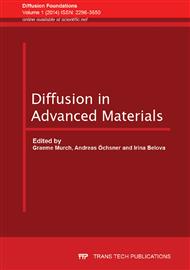[1]
P. Ayyub, V.R. Palkar, S. Chattopadhyay et al. Effect of Crystal Size Reduction on Lattice Symmetry and Cooperative Properties. Phys. Rev. B. v. 51, 9, (1995) pp.6135-6138.
DOI: 10.1103/physrevb.51.6135
Google Scholar
[2]
P. Mondal, D. Bhattacharya, P. Choudhury. Dielectric anomaly at orbital order-disorder transition in LaMnO3+d. J. Phys. Condens. Matter. (2006) V. 18, p.6869.
DOI: 10.1088/0953-8984/18/29/024
Google Scholar
[3]
N. Das, P. Mondal, D. Bhattacharya. Partical size dependence of orbital order-disorder transition in LaMnO3. Phys. Rev. B. (2006) v. 74, p.014410.
Google Scholar
[4]
V. Ya. Shevchenko, O.L. Khasanov, G.S. Yuryev. Coexistence of Cubic and Tetragonal Structures in Yttria-Stabilized Zirconia Nanoparticles - Inorganic Materials, Vol. 37, No. 9 (2001) p.950 – 952.
Google Scholar
[5]
Fishman A. Ya., Ivanov M.A., Petrova S.A., Zakharov R.G. Structural Phase Transitions in Mechanoactivated Manganese Oxides. Defect and Diffusion Forum. Vols. 297-301 (2010) pp.1306-1311.
DOI: 10.4028/www.scientific.net/ddf.297-301.1306
Google Scholar
[6]
S.A. Petrova, R.G. Zakharov, A. Ya. Fishman, L.I. Leontiev. Phase States of Mechanoactivated Manganese Oxides. The Optimization of Composition, Structure and Properties of Metals, Oxides, Composites, Nano- and Amorphous Materials. Proceedings of the Ninth Israeli-Russian Bi-National Workshop 2010, July 25-30, Belokurikha (2010).
DOI: 10.4028/www.scientific.net/ddf.297-301.1306
Google Scholar
[7]
A.V. Fetisov, A. Ya. Fishman, S.A. Petrova, R.G. Zakharov, E.A. Pastukhov. Structural Properties of Mechanoactivated Mn2O3. Proceedings of the Sixth International Conference "Mathematical Modeling and Computer Simulations of Material Technologies (MMT-2010), Ariel University Center of Samaria, Ariel, Israel 2010, pp.1-201.
Google Scholar
[8]
E.V. Vikhodetz, R,.G. Zakharov, M.A. Ivanov et al. Peculiarities of Jahn-Teller Structural Phase Transitions in the Nanosized Systems. Russ. J. Mater. Sci. Т. 138. № 9 (2008) С. 53-61.
Google Scholar
[9]
G. Tromel, W. Fix, K. Koch, and F. Schaberg, Erzmetall, 29(5), 234 (1976).
Google Scholar
[10]
A. Ya. Fishman, M.A. Ivanov, S.A. Petrova, R.G. Zakharov: Defect Diffusion Forum Vols. 297-301 (2010) p.1306.
DOI: 10.4028/www.scientific.net/ddf.297-301.1306
Google Scholar
[11]
V.V. Ziryanov, V.F. Sisoev, V.V. Boldirev, T.V. Korostileva: Patent USSR N 1375328.
Google Scholar
[12]
DiffracPlus: EVA, TOPAS Bruker AXS GmbH, Karlsruhe, Germany. (2008).
Google Scholar
[13]
D. Balzar: Voigt-function model in diffraction line-broadening analysis. - Microstructure Analysis from Diffraction, edited by R. L. Snyder, H. J. Bunge, and J. Fiala, International Union of Crystallography (1999).
Google Scholar
[14]
A. Ya. Fishman, M.A. Ivanov, S.A. Petrova et al.: Defect Diffusion Forum Vols. 283-286 (2009) p.53.
Google Scholar
[15]
R.G. Zakharov, S.A. Petrova, A.E. Udilov, A.N. Petrov, A.I. Vylkov, V.L. Lisin. Patent RU №72329, 2008, IB No. 10.
Google Scholar
[16]
P.Z. Si, E. Bruck, Z.D. Zhang, O. Tegus, W.S. Zhang, K.H.J. Buschow, J.C.P. Klaasse: Mater. Res. Bull. V. 40 (2005) p.29.
Google Scholar
[17]
A.E. Berkowitz, G.F. Rodriguez, J.I. Hong, K. An, T. Hyeon, N Agarwa, D.J. Smith, E.E. Fullerton: J. Phys. D: Appl. Phys. V. 41 (2008) p.134007.
Google Scholar
[18]
M. Regulski, R. Przenioslo, I. Sosnowska, D. Howhlwein, and R. Schneider: J. Alloys Compd. Vol. 362, (2004) p.236.
Google Scholar
[19]
N. Yamamoto, T. Endo, M. Shimada, and T. Takada: Jap. J. Appl. Phys. V. 13 (1974) p.723.
Google Scholar
[20]
V.B. Vykhodets, E.V. Vykhodets, B.A. Gizhevskii et al: JETP Letters Vol. 87, (2008) p.115.
Google Scholar
[21]
A. Ya. Fishman, T.E. Kurennykh, S.A. Petrova et al: J. Nano Research Vol. 7 (2009) p.33.
Google Scholar
[22]
A. Fishman, T. Kurennykh, V. Vykhodets and E. Vykhodets, in: Advances in Ceramics - Characterization, Raw Materials, Processing, Properties, Degradation and Healing, edited by Costas Sikalidis InTech - Open Access Publisher, Rijeka, Croatia (2011).
DOI: 10.5772/19122
Google Scholar
[23]
A. Ya. Fishman, T.E. Kurennykh et al.: Defect Diffusion Forum Vols. 326-328 (2012) p.713.
Google Scholar


